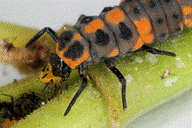Papers in the Biological Sciences

Brigitte Tenhumberg Papers
Document Type
Article
Date of this Version
2014
Citation
Published in New Phytologist 202:4 (2014), pp. 1346–1356; doi: 10.1111/nph.12730
Abstract
Microorganisms are ubiquitous and thought to regulate host populations. Although microorganisms can be pathogenic and affect components of fitness, few studies have examined their effects on wild plant populations. As individual traits might not contribute equally to changes in population growth rate, it is essential to examine the entire life cycle to determine how microorganisms affect host population dynamics. In this study, we used data from common garden experiments with plants from three Cucurbita pepo populations exposed to three virus treatments. These data were used to parameterize a deterministic matrix model, which allowed us to estimate the effect of virus on components of fitness and population growth rate. Virus did not reduce fruit number, but population growth rates varied among virus treatments and wild C. pepo populations. The effect of virus on population growth rate depended on virus species and wild C. pepo population. Contributions of life-history transitions and life-history traits to population growth rates varied among populations and virus treatments. However, this population– virus interaction was not evident when examining individual components of fitness. Thus, caution must be used when interpreting the effects of changes in individual traits, as single traits do not always predict population-level change accurately.
Included in
Biology Commons, Plant Pathology Commons, Population Biology Commons


Comments
Copyright © 2014 Holly R. Prendeville, Brigitte Tenhumberg, and Diana Pilson. Published by the New Phytologist Trust and John Wiley & Sons. Used by permission.